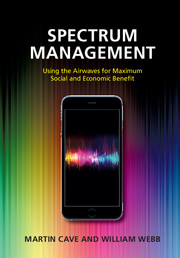Book contents
- Frontmatter
- Contents
- Preface
- Acknowledgments
- Plan of the book
- List of abbreviations
- Part I Fundamentals
- Part II Economic management of spectrum
- Part III Sharing and other emerging approaches to spectrum management
- 8 Spectrum sharing and the commons
- 9 Dynamic spectrum access
- 10 Controlling interference: licensing and receivers
- Part IV Case studies and conclusions
- About the authors
- Index
- References
9 - Dynamic spectrum access
from Part III - Sharing and other emerging approaches to spectrum management
Published online by Cambridge University Press: 05 November 2015
- Frontmatter
- Contents
- Preface
- Acknowledgments
- Plan of the book
- List of abbreviations
- Part I Fundamentals
- Part II Economic management of spectrum
- Part III Sharing and other emerging approaches to spectrum management
- 8 Spectrum sharing and the commons
- 9 Dynamic spectrum access
- 10 Controlling interference: licensing and receivers
- Part IV Case studies and conclusions
- About the authors
- Index
- References
Summary
Introduction
The previous chapter touched on the concept that devices could share spectrum on a “dynamic” basis. So, for example, if a primary user was not using spectrum in a given location at a particular time then a secondary user might opportunistically make use of it. This could be considered to be an extension of light licensing where the database recording usage became more real-time and able to perform coexistence calculations.
The rationale for a more dynamic access is that despite the apparent scarcity of spectrum, observations of actual usage appear to suggest that it is far from full. Observing spectrum usage is a relatively crude process. It involves setting up a receiver that can scan through a range of frequency bands and noting those bands in which energy was received. These are assumed used, whereas the bands where no energy was seen are assumed empty. There are many problems with this approach:
• The receiver may not be able to hear the signal because of local blocking. For example, uplink signals from mobile phones to a nearby base station would be very difficult to receive at a scanning receiver unless it was located close to the base station.
• The band may be used for applications such as radio astronomy where the absence of man-made signals is necessary.
• The band may be used for satellite transmissions and unless the scanning receiver has an upwardly pointing dish it may not receive these.
• Applications such as radar can be very difficult to receive as they only emit short pulses of energy and the probability of the pulse coinciding with the radar pointing at the scanning receiver and the scanning receiver being tuned to the radar frequency at that point in its scan is low.
• Many applications require that the same frequency is not used in neighboring cells. Hence only about 25% of frequencies can be used in one cell, with these frequencies being reused in distant, noncontiguous cells. So although 75% of the spectrum is unused, it is not available to other similar-power applications as that would lead to interference.
- Type
- Chapter
- Information
- Spectrum ManagementUsing the Airwaves for Maximum Social and Economic Benefit, pp. 162 - 191Publisher: Cambridge University PressPrint publication year: 2015



